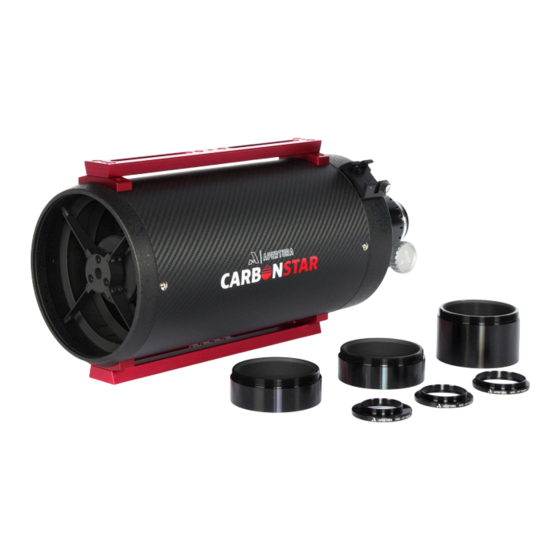
Advertisement
Quick Links
Advertisement

Summary of Contents for Apertura Carbon Star CS-6RC
- Page 1 Carbon Star 150mm Ritchey-Chretien User’s Manual By Matthew M Paul 2024...
- Page 2 Overview The Apertura Carbon Star 150mm Ritchey-Chretien is an f/9 coma free telescope that is perfect for deep sky imaging. A Ritchey-Chretien uses a very fast hyperbolic primary mirror and a much smaller convex hyperbolic secondary mirror to direct the focused light out the back of the telescope and into your eyepiece or camera.
- Page 3 What is a Ritchey-Chretien Telescope and why use it? The Ritchey-Chretien Telescope (RCT or more commonly RC) is a two mirror telescope developed by George Ritchey and is based on the famous Cassegrain design developed by Laurent Cassegrain. It is one of the most popular professional telescope types in use today. The Ritchey-Chretien uses a two mirror compound optical design much like the ever popular Schmidt Cassegrain Telescope (SCT) or Maksutov-Cassegrain telescopes, however it does not need the refractive lens “Reading Glasses”...
- Page 4 Application for the telescope The Apertura Carbon Star 150mm Ritchey-Chretien is a very flexible system that is well suited to astrophotography of large diffuse nebulae, as well as small planetary nebulae. The telescope is also a great option to exoplanet transit observations, variable star observations, and multi aperture photometry of all sorts.
- Page 5 Focuser The Carbon Star 150mm Imaging RC has an all new focuser! It is a linear bearing focuser which is strong and can support a cooled astronomy camera, electronic filter wheel, off axis guider, and coma corrector. What exactly is a linear bearing focuser? This focuser design is similar to a Crayford but uses a 100mm long rail which is supported by dozens of precision ball bearings that ride in a...
-
Page 6: Using The Telescope
The focuser also can use the standard compression ring and nose piece method. This all new threaded system is designed to be used in conjunction with the all new Apertura Camera Rotator (APT-CAS-M56CAA). - Page 7 Focusing We’ve taken the time to calculate the base focus position for a variety of systems. Due to the immense flexibility of the RC telescope we can not account for every possible scenario. But, we have calculated the position for some of the more commonly encountered combinations, without a reducer.
- Page 8 50mm and a 25mm focuser spacer. Threaded Connection, Camera Rotator, and Tilt Plate If using the Apertura Ritchey-Chretien Focuser Tilt Plate APT-RCTILT-S (optional accessory) in conjunction with the Apertura M56 Camera Rotator APT-CAS-M56CAA (optional accessory) and threaded connection, only the single 50mm spacer should be used and focus should be found at the 24mm position.
- Page 9 EAF Installation 1. Remove the coarse focus knob by 5. Then tighten the two M4 screws from loosening the internal set screw using a the motor to the bracket. Then, tighten 2mm hex key. the focuser shaft fitting screws on to the focuser shaft.
- Page 10 Newtonian telescope and it does not need to be painfully difficult or overly complex to produce good images. To collimate an RC telescope with the Apertura CCE replace the camera with the 2” to 1.25” adapter. Looking through the focuser, note the doughnut shaped center spot on the secondary mirror.
- Page 11 slightly defocus the star. You’ll need to zoom in using your imaging software to see the details necessary. If the star is defocused too much, the detail necessary to perfect the collimation will not be visible. When the star is ever so slightly defocused, a small spot can be seen at the center.
-
Page 12: Warranty
Warranty The Apertura Absolute Warranty provides two years of coverage against product defects. After the initial two-year warranty expires, this product qualifies for Apertura's Three-Year Accident Replacement Program. In addition, the Apertura Absolute Warranty is transferable! It is important to keep your original receipt and the product's original boxes and packaging, should...






Need help?
Do you have a question about the Carbon Star CS-6RC and is the answer not in the manual?
Questions and answers